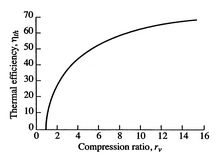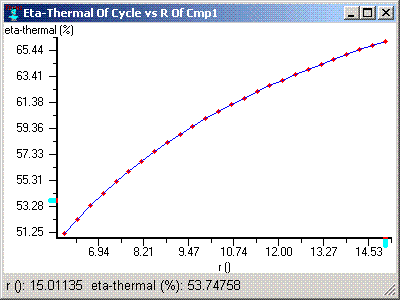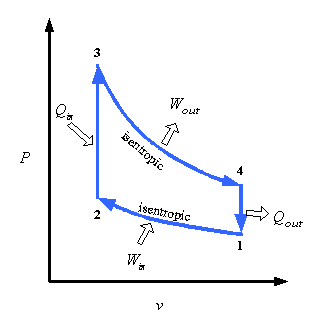 05-12-2011, 07:42 PM
05-12-2011, 07:42 PM
|
#11 (permalink)
|
|
Moderate your Moderation.
Join Date: Nov 2008
Location: Troy, Pa.
Posts: 8,919
Pasta - '96 Volkswagen Passat TDi 90 day: 45.22 mpg (US)
Thanks: 1,369
Thanked 430 Times in 353 Posts
|
You got it. Faster pressure rise.
__________________
"¿ʞɐǝɹɟ ɐ ǝɹ,noʎ uǝɥʍ 'ʇı ʇ,usı 'ʎlǝuol s,ʇı"

|
|
|

|
 Today Today
|
|
|
|
 Other popular topics in this forum...
Other popular topics in this forum...
|
|
|
|
 05-12-2011, 08:14 PM
05-12-2011, 08:14 PM
|
#12 (permalink)
|
|
Diesel Addict/No Cure
Join Date: Apr 2011
Location: chicago, il
Posts: 787
Thanks: 130
Thanked 74 Times in 49 Posts
|
Quote:
Originally Posted by redpoint5

Why don't manufacturers turbo-charge all cars? It seems a sure bet it would more than pay for itself by avoiding the need to build a bigger engine, and in fuel savings.
My point is, it would actually be desirable for fuel to instantly combust if it is directly injected into the cylinder just at the right moment in the engine cycle. It shouldn't then matter what octane the fuel is since we want it to burn right as it gets squirted in. Diesels do this.
Surely gasoline engines can be designed to withstand the increased pressures, heat and such. Diesel engines do this while burning a fuel that has 30% more energy density.
|
It gets back to the chemistry of the fuel. Even though gasoline direct injection and diesel direct injection do the same thing, the fuel reacts differently.
Look at what happens between seasons with the blends of gasoline and diesel. Mileage usually drops. Gasoline with ethanol versus alcohol free gasoline, there is a mileage difference. It's like that because the fuels are designed to burn instead of instantly combust like you mentioned, and because of this, no engine running on what is accessible at the pump will run as good as it could.
The engineers and chemists can do a lot more in terms of efficiency, but are only going to be allowed to go so far with it because of business. It's unfortunate, but that's the reality.
__________________
Volvo WIA42 VED-12 / 335 hp / 1300 ft/lbs / 9 mpg
Big n' Boxy, Never met a Hill it Didn't Like
|
|
|

|
 05-12-2011, 09:34 PM
05-12-2011, 09:34 PM
|
#13 (permalink)
|
|
Engineering first
Join Date: Mar 2009
Location: Huntsville, AL
Posts: 851
Thanks: 98
Thanked 251 Times in 160 Posts
|
Quote:
Originally Posted by redpoint5

Why don't manufacturers turbo-charge all cars? It seems a sure bet it would more than pay for itself by avoiding the need to build a bigger engine, and in fuel savings. . . .
|
That is happening but technology often moves forward in fits and spurts. Every part in a car adds to the cost sometimes and the accountants who run companies choose a less than optimum solution for one that is "good enough." This penny-wise but pound foolish attitude (aka., their own pay and benefits) almost killed two of three USA car makers and for Chrysler, this is their second time at bat.
Bob Wilson
__________________
2019 Tesla Model 3 Std. Range Plus - 215 mi EV
2017 BMW i3-REx - 106 mi EV, 88 mi mid-grade
Retired engineer, Huntsville, AL
|
|
|

|
|
The Following User Says Thank You to bwilson4web For This Useful Post:
|
|
 05-12-2011, 10:01 PM
05-12-2011, 10:01 PM
|
#14 (permalink)
|
|
Master EcoModder
Join Date: Sep 2009
Posts: 5,927
Thanks: 877
Thanked 2,024 Times in 1,304 Posts
|
The new Mazda skyactive system uses 14 to 1 compression with fuel injected directly into the combustion chamber in stages at very high pressures. Fuel is initially introduced to get ignition, then fuel is added during combustion to eliminate the shock wave of pre ignition.
Ultra high pressure (like 2800+ PSI) actually exceeds combustion pressure. Direct injection allows the fuel to absorb heat directly from the combustion chamber, and the multiple injections prevent pre ignition by not allowing a sufficient quantity of fuel to preignite in the first place.
All of these developments are in the direction of the goal of true HCCI combustion (homogeneous charge compression ignition) where mixture ratios of 25 to 1 can be ignited without knock since the fuel air charge would be completely homogeneous at the point of combustion.
It may actually be done, and when it is with whatever combination actually gets the results, we may see IC engines that get 60% fuel conversion efficiency. Argonne labs is already working on that premise, and when it is done and capacitive storage and application of energy are combined, you will see 2000 pound 5 passenger sedans regularly getting over 100 MPG in normal operation, up to speeds of 70 + MPH as long as the aero is good enough to keep power requirements low at higher speeds.
regards
Mech
Last edited by user removed; 05-12-2011 at 10:16 PM..
|
|
|

|
|
The Following User Says Thank You to user removed For This Useful Post:
|
|
 05-12-2011, 10:14 PM
05-12-2011, 10:14 PM
|
#15 (permalink)
|
|
Master EcoModder
Join Date: Sep 2009
Posts: 5,927
Thanks: 877
Thanked 2,024 Times in 1,304 Posts
|
|
|
|

|
 05-13-2011, 02:27 PM
05-13-2011, 02:27 PM
|
#16 (permalink)
|
|
Human Environmentalist
Join Date: Aug 2010
Location: Oregon
Posts: 13,052
Thanks: 4,381
Thanked 4,562 Times in 3,508 Posts
|
Quote:
Originally Posted by bwilson4web

T... you might check the Wiki or ask Mr. Google. I'd have to reconstruct my college course notes (from 40 years ago!)
|
So far I'm disappointed at what Google has to say on the subject. From Wiki:
"A high compression ratio is desirable because it allows an engine to extract more mechanical energy from a given mass of air-fuel mixture due to its higher thermal efficiency."
In other words, a high compression ratio is more efficient because it is more efficient.
From answers.com:
"Engine efficiency is increased though compression ratio by allowing a more thermodynamic energy to be converted into mechanical energy. Energy transfer is the key to efficiency."
I believe all things can be distilled into a simple concept, but it's improper to define something by using the subject as the definition. Those that cannot explain something in lay terms often do not have a firm grasp of the concept themselves.
Now, I have a hard time understanding how a higher compression ratio equates to higher thermal efficiency in light of the 2nd law of thermal dynamics. In my mind, increasing pressure also increases the heat density of the fluid. Since energy always flows from higher concentrations to lower concentrations, this should mean that the highly compressed fluid would give up more of its heat energy to the surrounding cylinder walls, piston, and head. Fluid that is not compressed as much would not give up as much heat since the temperature differential is not as great.
So, something about the higher compression does cause greater thermal efficiency despite the heat that is lost due to the increased thermal density. The principle behind this is still a mystery to me. |
|
|

|
 05-13-2011, 03:16 PM
05-13-2011, 03:16 PM
|
#17 (permalink)
|
|
Diesel Addict/No Cure
Join Date: Apr 2011
Location: chicago, il
Posts: 787
Thanks: 130
Thanked 74 Times in 49 Posts
|
__________________
Volvo WIA42 VED-12 / 335 hp / 1300 ft/lbs / 9 mpg
Big n' Boxy, Never met a Hill it Didn't Like
|
|
|

|
 05-13-2011, 03:40 PM
05-13-2011, 03:40 PM
|
#18 (permalink)
|
|
Human Environmentalist
Join Date: Aug 2010
Location: Oregon
Posts: 13,052
Thanks: 4,381
Thanked 4,562 Times in 3,508 Posts
|
Quote:
Originally Posted by cleanspeed1

|
The link added this to the explanation:
"High ratios place the available oxygen and fuel molecules into a reduced space along with the adiabatic heat of compression - causing better mixing and evaporation of the fuel droplets. "
This statement implies that lower compression ratios do not adequately atomize the fuel/air charge. I'm wondering if there is something being left out of the explanation. Perhaps the increased pressure and heat also causes a more rapid burn, and therefore the expanding force has a longer stroke (duration) to perform work? After all, burning gas the moment before the exhaust ports open would allow only a very short duration for useful work to be extracted.
Setting this topic aside for the moment, I'm wondering what kind of real world efficiency gains I can expect from installing a turbo and swapping in a taller final drive. Of course the answer is that it depends, but I'm also considering a front grill block, and I wouldn't run a grill block if I had a turbo. So would I likely get more gains from a grill block, or from a turbo/gear install?
Last edited by redpoint5; 05-13-2011 at 04:06 PM..
|
|
|

|
 05-13-2011, 05:17 PM
05-13-2011, 05:17 PM
|
#19 (permalink)
|
|
Engineering first
Join Date: Mar 2009
Location: Huntsville, AL
Posts: 851
Thanks: 98
Thanked 251 Times in 160 Posts
|
Quote:
Originally Posted by redpoint5

So far I'm disappointed at what Google has to say on the subject. From Wiki:
"A high compression ratio is desirable because it allows an engine to extract more mechanical energy from a given mass of air-fuel mixture due to its higher thermal efficiency."
In other words, a high compression ratio is more efficient because it is more efficient.
From answers.com:
"Engine efficiency is increased though compression ratio by allowing a more thermodynamic energy to be converted into mechanical energy. Energy transfer is the key to efficiency."
. . . |
I'm sorry, I should have been more specific. So let's start with this URL:
Internal combustion engine - Wikipedia, the free encyclopedia
They don't really discuss compression ratio but this is the take away:
Quote:
. . .
The thermodynamic limits assume that the engine is operating in ideal conditions: a frictionless world, ideal gases, perfect insulators, and operation at infinite time. The real world is substantially more complex and all the complexities reduce the efficiency. In addition, real engines run best at specific loads and rates as described by their power band. For example, a car cruising on a highway is usually operating significantly below its ideal load, because the engine is designed for the higher loads desired for rapid acceleration. The applications of engines are used as contributed drag on the total system reducing overall efficiency, such as wind resistance designs for vehicles. These and many other losses result in an engine's real-world fuel economy that is usually measured in the units of miles per gallon (or fuel consumption in liters per 100 kilometers) for automobiles. The miles in miles per gallon represents a meaningful amount of work and the volume of hydrocarbon implies a standard energy content.
Most steel engines have a thermodynamic limit of 37%. Even when aided with turbochargers and stock efficiency aids, most engines retain an average efficiency of about 18%-20% . . . .
|
Practical, commonly sold engines have abysmal thermal dynamic efficiencies. To be perfectly blunt, they are rubbish compared to what they could (and should) achieve.
So lets switch to two university web pages that go into details addressing the effect of compression ratio:
3.5 The Internal combustion engine (Otto Cycle)
Design of an Otto Cycle
Both papers show the math to derive the same efficiency formula for a 'perfect' Otto cycle engine:
efficiency = 1 - ( 1 / (r ** (k-1) ) )
r - compression ratio
k - specific heat ratio, a measure of energy in the fuel
For simplicity, here is the MIT chart:

Here is the Northwestern chart:

Note they have have different scales with the MIT showing the full range and the Northwestern a more practical range we find today.
Now everything in these classical, Otto cycle lessons derives from the P-v diagram:

The top curve coming from point 3 towards point 4 is the power stroke curve and the longer it is, the more energy extracted. The x-axis is the "v" expansion ratio.
Bob Wilson
ps. I don't know if you are interested but the Prius Atkinson cycle takes the line from 1 to 2 and breaks it into two sections:
1 to 1.5 - this is a flat line as the intake valve is kept open and part of fuel-air mix goes back into the intake manifold to be sucked in the next cylinder.
1.5 to 2 - this is the shortened compression stroke which being smaller, means less compression losses.
Qs - the energy added is less because there is less fuel-air to burn
Qout - is the same
4 - is moved to the right about 50% further (aka., 13 to 1 expansion versus 9 to 1 typical compression ratio.) So the Prius has a much longer power stroke to extract more energy.
I do not like this P-v chart but it is 'close enough:'

I do not like it because the segment 3-4 implies a substantial increase in volume without work being done and that doesn't happen. If you stretch 4 over to combine it with 3, you'll have an accurate, Atkinson cycle P-v diagram.
Bob Wilson
__________________
2019 Tesla Model 3 Std. Range Plus - 215 mi EV
2017 BMW i3-REx - 106 mi EV, 88 mi mid-grade
Retired engineer, Huntsville, AL
Last edited by bwilson4web; 05-13-2011 at 05:55 PM..
|
|
|

|
|
The Following 3 Users Say Thank You to bwilson4web For This Useful Post:
|
|
 05-13-2011, 05:28 PM
05-13-2011, 05:28 PM
|
#20 (permalink)
|
|
Diesel Addict/No Cure
Join Date: Apr 2011
Location: chicago, il
Posts: 787
Thanks: 130
Thanked 74 Times in 49 Posts
|
I'll tell you what I would do if I had a TSX. With the type of powerband it has, I would either put an Eaton TVS style supercharger, a Lysholm screw compressor or a Rotrex on it and regear it. With the modern designs, the parasitic losses are not as bad ( they have a bypass when not in boost ), and the instant boost beefs up the bottom end torque really nice, which is what Honda engines need. The added air plus some careful tuning boosts the mileage, and the bottom end torque allows lower shift points. Not a cheap way to go, but what the heck, it's only money.
__________________
Volvo WIA42 VED-12 / 335 hp / 1300 ft/lbs / 9 mpg
Big n' Boxy, Never met a Hill it Didn't Like
|
|
|

|
|
The Following User Says Thank You to cleanspeed1 For This Useful Post:
|
|
|